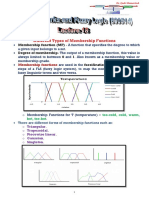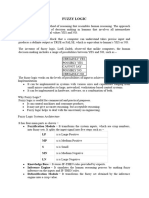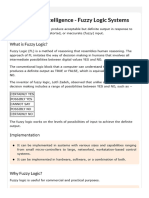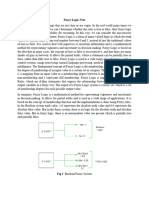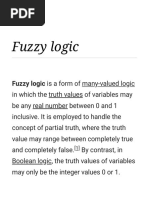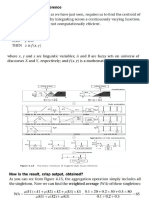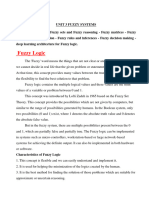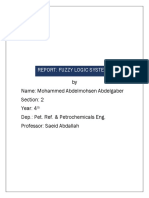0 ratings0% found this document useful (0 votes)
219 viewsFuzzy Final Assignment
This document describes a student's report on implementing a fuzzy logic system to solve a real-world problem. Specifically, it uses fuzzy logic to determine student placements in campus recruitments based on their CGPA and personality. It provides details on:
1) Describing the fuzzy logic algorithm and components like fuzzification, rule base, inference engine, and defuzzification.
2) Applying this to an example of controlling air conditioner temperature.
3) Explaining the problem of using fuzzy logic to determine student placements based on CGPA and personality.
Uploaded by
Harahari DonkeshwaramCopyright
© © All Rights Reserved
Available Formats
Download as PDF, TXT or read online on Scribd
0 ratings0% found this document useful (0 votes)
219 viewsFuzzy Final Assignment
This document describes a student's report on implementing a fuzzy logic system to solve a real-world problem. Specifically, it uses fuzzy logic to determine student placements in campus recruitments based on their CGPA and personality. It provides details on:
1) Describing the fuzzy logic algorithm and components like fuzzification, rule base, inference engine, and defuzzification.
2) Applying this to an example of controlling air conditioner temperature.
3) Explaining the problem of using fuzzy logic to determine student placements based on CGPA and personality.
Uploaded by
Harahari DonkeshwaramCopyright
© © All Rights Reserved
Available Formats
Download as PDF, TXT or read online on Scribd
You are on page 1/ 27
A REPORT ON
REAL LIFE APPLICATION OF FUZZY LOGIC
(WITH MATLAB IMPLIMENTATION)
Course: map 701
Submitted by:
DONKESHWARAM HARAHARI
(Entry no: 2010 MAS 7133)
Guidance by:
Dr. Ram laL
DEPARTMENT OF MATHEMATICS
INDIAN INSTITUTE OF TECHNOLOGY DELHI
NOVEMBER 4, 2011.
DECLARATION
Here in this report, I encapsulated my work on FUZZY LOGIC. So, I
explained my work in sequence as given below:
Brief introduction to fuzzy logic with small example on Air Conditioner
controlling according to variations in temperatures.
Brief explanation about a real life application example. i.e., on
PLACEMENTING of a student in campus recruitments based on his
CGPA and PERSONALITY.
Explanation of fuzzy logic algorithm through systematic steps using
above PLACEMENTING problem with matlab code.
The matlab code for the problem without using inbuilt matlab functions
The same problem is implemented by using GUI and compared with my
own code results.
I am grateful to Dr. Ram Lal for his constant motivation and guidance. I
am highly obliged to him for constantly encouraging us by giving his critics
on my work.
Date: November 4, 2011. DONKESHWARAM HARAHARI
(ENTRY NO: 2010 MAS7133)
1 .INTRODUCTION
Fuzzy logic is a form of many-valued logic; it deals with reasoning that is
approximate rather than fixed and exact. In contrast with traditional logic
theory, where binary sets have two-valued logic: true or false, fuzzy logic
variables may have a truth value that ranges in degree between 0 and 1. Fuzzy
logic has been extended to handle the concept of partial truth, where the truth
value may range between completely true and completely false. Furthermore,
when linguistic variables are used, these degrees may be managed by specific
functions (membership functions).
Fuzzy logic began with the 1965 proposal of fuzzy set theory by Lotfi
Zadeh. Fuzzy logic has been applied to many fields, from control
theory to artificial intelligence.
Now we explain the A fuzzy logic system (FLS)/ A fuzzy inference system
(FIS) systematically:
A fuzzy logic system (FLS) can be defined as the nonlinear mapping of an
Input data set to a scalar output data. A FLS consists of four main parts:
1. Fuzzifier, 2. Rules, 3.Inference engine, and 4.Defuzzifier. These
components and the general architecture of a FLS is shown in below
Figure.
Figure2: A Fuzzy Logic System
The process of fuzzy logic is explained in Algorithm given below:
Fuzzy logic algorithm:
1. Define the linguistic variables and terms (initialization)
2. Construct the membership functions (initialization)
3. Construct the rule base (initialization)
4. Convert crisp input data to fuzzy values (fuzzification).
using the membership functions
5. Evaluate the rules in the rule base (inference)
Applying Fuzzy Operators (min, max, product etc.) in each rule.
Applying Implication Operators (min, Larsen product etc.) in each rule.
6. Combine the results of each rule (inference)
By applying the Aggregation Operators.
7. Convert the output data to non-fuzzy values (defuzzification)
By finding centroid,bisectors etc. Of fuzzy output which we got from
above step.
**The process of fuzzy logic is explained in Algorithm:
Firstly, a crisp set of input data are gathered and converted to
a fuzzy set using fuzzy linguistic variables, fuzzy linguistic terms and
membership functions. This step is known as fuzzification. Afterwards, an
inference is made based on a set of rules. Lastly, the resulting fuzzy output is
mapped to a crisp output using the membership functions, in the defuzzification
step.
In order to exemplify the usage of a FLS, consider an air
conditioner system controlled by a FLS (Figure given below). The system
adjusts the temperature of the room according to the current temperature of the
room and the target value.
The fuzzy engine periodically compares the room temperature and the target
Temperature, and produces a command to heat or cool the room.
**Linguistic Variables:
Linguistic variables are the input or output variables of the system whose
values are words or sentences from a natural language, instead of numerical
values. A linguistic variable is generally decomposed into a set of linguistic
terms.
Example:
Consider the air conditioner in Figure 2. Let temperature (t) is the
Linguistic variable which represents the temperature of a room. To qualify the
Temperature, terms such as hot and cold are used in real life. These
are the Linguistic values of the temperature. Then, T (t) = {too-cold, cold,
warm, hot, too-hot} can be the set of decompositions for the linguistic variable
temperature. Each member of this decomposition is called a linguistic term and
can cover a Portion of the overall values of the temperature.
**Membership Functions:
Membership functions are used in the fuzzification and defuzzification
steps of a FLS, to map the non-fuzzy input values to fuzzy linguistic terms and
vice versa. A membership function is used to quantify a linguistic term. For
instance, In below Figure, membership functions for the linguistic terms of
temperature variable are plotted. Note that, an important characteristic of fuzzy
logic is that a numerical value does not have to be fuzzified using only one
membership function. In other words, a value can belong to multiple sets at the
same time. For example, according to Figure 3, a temperature value can be
considered as cold and too-cold at the same time, with different
degree of memberships.
Membership Functions for T(temperature) = {too-cold, cold, warm, hot, too-
hot} figure 3
There are different forms of membership functions such as triangular,
trapezoidal, piecewise linear, Gaussian, or singleton (Figure given below).
The most common types of membership functions are triangular, trapezoidal,
and Gaussian shapes. The type of the membership function can be context
dependent and it is generally chosen arbitrarily according to the user
experience.
Different Types of Membership Functions.
**Fuzzy Rules :
In a FLS, a rule base is constructed to control the output variable. A fuzzy
Rule is a simple IF-THEN rule with a condition and a conclusion. In Table 1,
Sample fuzzy rules for the air conditioner system in its corresponding figure
above. Table 2 shows the matrix representation of the fuzzy rules for the said
FLS. Row captions in the matrix contain the values that current room
temperature can take, column captions contain the values for target
temperature, and each cell is the resulting command when the input variables
take the values in that row and column. For instance, the cell (3, 4) in the
matrix can be read as follows: If temperature is cold and target is warm then
command is heat.
**Fuzzy Set Operations:
The evaluations of the fuzzy rules and the combination of the results of the
Individual rules are performed using fuzzy set operations. The operations on
Fuzzy sets are different than the operations on non-fuzzy sets. Let
A
and
A
are the membership functions for fuzzy sets A and B. Table 3 contains possible
fuzzy operations for OR and AND operators on these sets, comparatively. The
mostly used operations for OR and AND operators are max and min,
respectively. For complement (NOT) operation, Eq. 1 is used for fuzzy sets.
After evaluating the result of each rule, these results should be combined to
Obtain a final result. This process is called inference. The results of individual
Rules can be combined in different ways. Table 4 contains possible
accumulation methods that are used to combine the results of individual rules.
The maximum algorithm is generally used for accumulation.
**Defuzzification :
After the inference step, the overall result is a fuzzy value. This result
should be defuzzified to obtain a final crisp output. This is the purpose of the
defuzzifier component of a FLS. Defuzzification is performed according to the
membership function of the output variable. For instance, assume that we have
the result in Figure 5 at the end of the inference. In this figure, the shaded areas
all belong to the fuzzy result. The purpose is to obtain a crisp value,
represented with a dot in the figure, from this fuzzy result.
There are different algorithms for defuzzification too. The mostly used
algorithms are listed in Table 5. The meanings of the variables used in Table 5
are explained in Table 6.
2. THE PLACEMENTING PROBLEM DESCRIPTION
Now I will discuss about Placementing problem. The problem is if we
have data called CGPA,PERSONOLITY LEVEL then we have decide that
which type of placement he will get in his campus placements. i.e., whether
will he get good, avg or no placement etc.
So, I developed a fuzzy inference system for the above decision making
problem Using different rule bases. The various components of the problem
used in the developed fuzzy system are:
1. Crisp inputs:
Two 1. CGPA with rage [1, 10]
2. PERSONOLITY LEVEL with range [1,10]
2. Crisp outputs:
One TYPE OF THE PLACEMENT
3. Membership functions used:
Three 1. Triangular
2. Trepezoidal
3. Gaussian
4. Linguistic variables:
CGPA: = {Outstanding, Excellent, Good, Average, Poor}
PERSONOLITY :={ Good, Average, Poor}
PLACEMENT :={ Good, Good, No placement}
5. FUZZY RULES USED:
1. (OUTSTANDING) || (GOOD) ==>GOOD
2. (EXCELLENT) && (AVG) ==>GOOD
3. (GOOD) && (GOOD) ==>GOOD
4. (EXCELLENT) || (GOOD) ==>AVG
5. (GOOD) && (AVG) ==>AVG
6. (AVG) && (AVG) ==>AVG
7. (POOR) || (POOR) ==>NO PLACEMENT
6. Fuzzy operators used :
AND min
OR max
7. Implication method used: min
8. Aggregation method used: max
9.Defuzzifiaction method used: Centroid
Using above components I have constructed the Fuzzy Inference system :
1. By without using Inbuilt matlab functions and
2. By without using Inbuilt matlab functions i.e., using GUI.
And I have compared both the results from above two methods. The results are
same i.e., are equivalent.
3. MATLAB CODE FOR FUZZY LOGIC ALGORITHM
FOR THE ABOVE PLACEMENTING PROBLEM
(Without using inbuilt functions)
%---------------------------------------------------------------
%FUZZY INFERENCE SYSTEM PLACEMENTING PROBLEM
%AUTHOR: DONKESHWARAM HARAHARI (2010MAS7133)
%---------------------------------------------------------------
%-----------
% INPUTS :
%-----------
% 1.CGPA,2.PERSONOLITY
%----------
% OUTPUT :
%----------
%1.PLACEMENT
%----------------------
% UNIVERSE OF DICOURSE:
%----------------------
x = 0:0.1:10; % FOR BOTH INPUTS
y = 0:0.1:10; % FOR OUTPUT,'PLACEMENT'
%-----------------------
% LINGUISTIC VARIABLES:
%-----------------------
% CGPA = {outstanding, excellent, good, avg, poor}
% PERSONOLITY = {good, average, poor}
%PLACEMENT = {good, avg, noplacement}
%-------------------------------------
% COBNSTRUCTION MEMBERSHIP FUNCTIONS:
%-------------------------------------
% FOR CGPA:
outstanding_mf1=trapzoid(x,[8.1 9.24 10.6 13.3]);
excellent_mf1 = triangle(x,[7.041 8.02 9.43]);
good_mf1 = triangle(x,[5.507 7.017 8.197]);
avg_mf1=triangle(x,[4.63 5.61 7.02]);
poor_mf1 = trapzoid(x,[-1.18 0.0107 2.98 3.97]);
mf1 = [outstanding_mf1;excellent_mf1;good_mf1;avg_mf1;poor_mf1];
figure(1)
plot(x,mf1)
title('OUTSTANDING,EXCELLENT,GOOD,AVG,POOR CGPAS')
xlabel('CGPA')
ylabel('MEMDERSHIP')
% FOR PERSONOLITY:
good_mf2 = trapzoid(x,[6.5 8.5 10.3 13.7]);
avg_mf2=triangle(x,[3 6 8]);
poor_mf2 = trapzoid(x,[-3.13 0.0701 2 4]);
mf2 = [good_mf2;avg_mf2,;poor_mf2];
figure(2)
plot(x,mf2)
title('GOOD,AVERAGE,POOR PERSONOLITY')
xlabel('PERSONOLITY')
ylabel('MEMDERSHIP')
% FOR PLACEMENT:
good_mf3 = trapzoid(x,[7.04 8.92 11 19]);
avg_mf3 = gaussian(x,[0.902 5.816]);
noplacement_mf3 = trapzoid(x,[-7.02 0.0962 2.19 3.96]);
mf3 = [good_mf3;avg_mf3,;noplacement_mf3];
figure(3)
plot(x,mf3)
title('GOOD,AVERAGE,NO PLACEMENTS')
xlabel('PLACEMENT')
ylabel('MEMBERSHIP')
%-------------------------------------------------
FUZZY RULES ARE :
%-------------------------------------------------
% 1.(OUTSTANDING)||(GOOD)==>GOOD
% 2.(EXCELLENT)&&(AVG)==>GOOD
% 3.(GOOD)&&(GOOD)==>GOOD
% 4.(EXCELLENT)||(GOOD)==>AVG
% 5.(GOOD)&&(AVG)==>AVG
% 6.(AVG)&&(AVG)==>AVG
% 7..(POOR)||(POOR)==>NO PLACEMENT
%--------------------------------------------------
%The five steps of evaluating fuzzy algorithms
%--------------------------------------------------
% 1. Fuzzify the input.
% 2. Apply a fuzzy operator.
% 3. Apply an implication operation.
% 4. Aggregate the outputs.
% 5. Defuzzify the output.
%---------------------------------------------------
%1.FUZZIFYING INPUT:
%---------------------------------------------------
IP=input('\n ENTER THE INPUT AS ROW VECTOR (CGPA,PERSONOLITY) :');
fuzzy_input1=mf1(:,find(x'==IP(1)));
fuzzy_input2=mf2(:,find(x==IP(2)));
%----------------------------------------------------
% 2.APPLYING FUZZY OPERATORS(AND,OR etc.)
% NOTE:Here we taken as AND-->MIN,OR-->MAX
%----------------------------------------------------
% RULE1:
antecedent(1)=max(fuzzy_input1(1),fuzzy_input2(1));
% RULE2:
antecedent(2)=min(fuzzy_input1(2),fuzzy_input2(2));
% RULE3:
antecedent(3)=min(fuzzy_input1(3),fuzzy_input2(1));
% RULE4:
antecedent(4)=max(fuzzy_input1(2),fuzzy_input2(1));
% RULE5:
antecedent(5)=min(fuzzy_input1(3),fuzzy_input2(2));
% RULE6:
antecedent(6)=min(fuzzy_input1(4),fuzzy_input2(2));
% RULE7:
antecedent(7)=min(fuzzy_input1(5),fuzzy_input2(3));
%---------------------------------------------------------
% 3.APPLYING IMPLICATION OPERATIONS
% NOTE:Here we applied 'MIN' as implication operations.
%---------------------------------------------------------
% RULE1:
consequent1=min(antecedent(1),mf3(1,:));
figure(4);plot(y,consequent1);title('CONSEQUENT1');
xlabel('PLACEMENT');ylabel('MEMBERSHIP');
% RULE2 :
consequent2=min(antecedent(2),mf3(1,:));
figure(5);plot(y,consequent2);title('CONSEQUENT2');
xlabel('PLACEMENT');ylabel('MEMBERSHIP');
% RULE3 :
consequent3=min(antecedent(3),mf3(1,:));
figure(6);plot(y,consequent3);title('CONSEQUENT3');
xlabel('PLACEMENT');ylabel('MEMBERSHIP');
% RULE4:
consequent4=min(antecedent(4),mf3(2,:));
figure(7);plot(y,consequent4);title('CONSEQUENT4');
xlabel('PLACEMENT');ylabel('MEMBERSHIP');
% RULE5 :
consequent5=min(antecedent(5),mf3(2,:));
figure(8);plot(y,consequent5);title('CONSEQUENT5');
xlabel('PLACEMENT');ylabel('MEMBERSHIP');
% RULE6 :
consequent6=min(antecedent(6),mf3(2,:));
figure(9);plot(y,consequent6);title('CONSEQUENT6');
xlabel('PLACEMENT');ylabel('MEMBERSHIP');
% RULE7 :
consequent7=min(antecedent(7),mf3(3,:));
figure(10);plot(y,consequent7);title('CONSEQUENT7');
xlabel('PLACEMENT');ylabel('MEMBERSHIP');
%------------------------------------------------------------------------
% 4.AGGREGATING THE OUTPUTS(i.e.,CONSEQUENTS BY IMPLICATION OPERATION)
% NOTE :Here we used 'MAX' as aggregating method.
%------------------------------------------------------------------------
fuzzy_output=max([consequent1;consequent2;consequent3;consequent4;conseque
nt5;consequent6;consequent7]);
figure(11);plot(y,fuzzy_output);title('FUZZY OUTPUT');
xlabel('PLACEMENT');ylabel('MEMBERSHIP');
%-------------------------------------------------------------------------
% 5.DEFUZZIFYING THE NONCRISP OUTPUT WHICH IS GOT FROM AGGREGIATION
%-------------------------------------------------------------------------
center=(y*fuzzy_output')/sum(fuzzy_output);
output=center
figure(12);plot(y,fuzzy_output);title('CRISP OUTPUT');
xlabel('PLACEMENT');ylabel('MEMBERSHIP');hold on;
t=ones(size(fuzzy_output))*output;
plot(t,fuzzy_output)
disp('The crisp output is : ');
disp(output);
fprintf('SO %f percent PLACEMENT \n',output*10);
%-------------------------------------------------------------------------
The matlab codes for functions used in above programme are given below with
their actual mathematical definition:
1.Triangular function :
The matlab code is for above function is:
%------------------------------------------------------------------
% Function for constructing triangle Membership function
%------------------------------------------------------------------
function y = triangle(x, params)
if nargin ~= 2
error('Two arguments are required by the triangular MF.');
elseif length(params) < 3
error('The triangular MF needs at least three parameters.');
end
a = params(1); b = params(2); c = params(3);
if a > b,
error('Illegal parameter condition: a > b');
elseif b > c,
error('Illegal parameter condition: b > c');
elseif a > c,
error('Illegal parameter condition: a > c');
end
y = zeros(size(x));
% Left and right shoulders (y = 0)
index = find(x <= a | c <= x);
y(index) = zeros(size(index));
% Left slope
if (a ~= b)
index = find(a < x & x < b);
y(index) = (x(index)-a)/(b-a);
end
% right slope
if (b ~= c)
index = find(b < x & x < c);
y(index) = (c-x(index))/(c-b);
end
% Center (y = 1)
index = find(x == b);
y(index) = ones(size(index));
2.Trepezoidal Function:
The matlab code for above function :
%-------------------------------------------------------------
%FUNCTION FOR CONSTRUCTING TREPEZOIDAL FUNCTION
%------------------------------------------------------------
function y = trapzoid(x, params)
if nargin ~= 2
error('Two arguments are required by the trapezoidal MF.');
elseif length(params) < 4
error('The trapezoidal MF needs at least four parameters.');
end
a = params(1); b = params(2); c = params(3); d = params(4);
if a > b,
error('Illegal parameter condition: a > b');
elseif c > d,
error('Illegal parameter condition: c > d');
end
y1 = zeros(size(x));
y2 = zeros(size(x));
% Compute y1
index = find(x >= b);
if ~isempty(index),
y1(index) = ones(size(index));
end
index = find(x < a);
if ~isempty(index),
y1(index) = zeros(size(index));
end
index = find(a <= x & x < b);
if ~isempty(index) & a ~= b,
y1(index) = (x(index)-a)/(b-a);
end
% Compute y2
index = find(x <= c);
if ~isempty(index),
y2(index) = ones(size(index));
end
index = find(x > d);
if ~isempty(index),
y2(index) = zeros(size(index));
end
index = find(c < x & x <= d);
if ~isempty(index) & c ~= d,
y2(index) = (d-x(index))/(d-c);
end
% Compute y
y = min(y1, y2);
3.Gaussian function :
For given vector x, the Gaussian function is defined by:
Where
2
variance and cmean of the distribution.
The matlab code for the function is :
%-------------------------------------------------------------
%FUNCTION FOR CONSTRUCTING THE GAUSSIAN MEMBERSHIP FUNCTION
%-------------------------------------------------------------
function y = gaussian(x, params)
if nargin ~= 2
error('Two arguments are required by the Gaussian MF.');
elseif length(params) < 2
error('The Gaussian MF needs at least two parameters.');
elseif params(1) == 0,
error('The Gaussian MF needs a non-zero sigma.');
end
sigma = params(1); c = params(2);
y = exp(-(x - c).^2/(2*sigma^2));
Next we will see the output for above matlab code.
**THE OUTPUT FOR THE ABOVE MATLAB CODE:
>> fuzzy placing
ENTER THE INPUT AS ROW VECTOR (CGPA,PERSONOLITY) :[6.1 8.2]
The crisp output is : 7.2369
SO 72.369244 percent PLACEMENT
>>
4. FUZZY LOGIC OUTPUT FOR PLACEMENT PROBLEM
(With using GUI Tool box of Matlab)
>> fuzzy placing
5.Conclusion:
We can construct Fuzzy logic Inference System for various
Real life problems involving Human like reasoning,decision
taking and controllong systems.
I must mention here that The Output from my own code
and GUI Tool Box is same with 0.0001 error. So I reached to
constructing good FIS.
You might also like
- Property and Social Relations in Melanesian Anthropology (J. Carrier)No ratings yetProperty and Social Relations in Melanesian Anthropology (J. Carrier)21 pages
- Lecture 18 - Different Types of Membership Functions 1No ratings yetLecture 18 - Different Types of Membership Functions 14 pages
- Lecture 18 - Different Types of Membership Functions 1No ratings yetLecture 18 - Different Types of Membership Functions 14 pages
- Artificial Intelligence - Fuzzy Logic SystemsNo ratings yetArtificial Intelligence - Fuzzy Logic Systems9 pages
- Artificial Intelligence - Fuzzy Logic SystemsNo ratings yetArtificial Intelligence - Fuzzy Logic Systems9 pages
- Practical 7 Introduction To Fuzzy LogicNo ratings yetPractical 7 Introduction To Fuzzy Logic20 pages
- Artificial Intelligence - Fuzzy Logic SystemsNo ratings yetArtificial Intelligence - Fuzzy Logic Systems6 pages
- Fuzzy Logic: UIET (Computer Science Deptt)100% (1)Fuzzy Logic: UIET (Computer Science Deptt)56 pages
- Speed Regulation in Fan Rotation Using Fuzzy Inference SystemNo ratings yetSpeed Regulation in Fan Rotation Using Fuzzy Inference System6 pages
- Adaptive Neuro-Fuzzy Inference System: 3.1 Introduction To Fuzzy LogicNo ratings yetAdaptive Neuro-Fuzzy Inference System: 3.1 Introduction To Fuzzy Logic14 pages
- Fuzzy Set Theory: Classical Set:-A Classical Set "A" Is A CollectionNo ratings yetFuzzy Set Theory: Classical Set:-A Classical Set "A" Is A Collection71 pages
- Revised General Test/Gross Point Average System Via Fuzzy Logic Techniques100% (1)Revised General Test/Gross Point Average System Via Fuzzy Logic Techniques9 pages
- A Short Review of Fuzzy Linear Equation SystemsNo ratings yetA Short Review of Fuzzy Linear Equation Systems5 pages
- 4.1 Fuzzy Logic Architecture and Set TheoryNo ratings yet4.1 Fuzzy Logic Architecture and Set Theory16 pages
- Membership Function Formulation Methods For Fuzzy Logic Systems: A Comprehensive ReviewNo ratings yetMembership Function Formulation Methods For Fuzzy Logic Systems: A Comprehensive Review17 pages
- Fuzzy Logic and Its Applications: by Swaroop.M.R 2SD07CS106 Under The Guidance of TGSNo ratings yetFuzzy Logic and Its Applications: by Swaroop.M.R 2SD07CS106 Under The Guidance of TGS25 pages
- Fuzzy Logic: Presented by Wei Zhang CSE Dept. Lehigh UniversityNo ratings yetFuzzy Logic: Presented by Wei Zhang CSE Dept. Lehigh University35 pages
- Optimization Fuzzy Logic Inference ArchitectureNo ratings yetOptimization Fuzzy Logic Inference Architecture5 pages
- Talent Management Is A Set of Integrated Organizational HR Processes Designed To AttractNo ratings yetTalent Management Is A Set of Integrated Organizational HR Processes Designed To Attract8 pages
- Family Law in The Philippines An OverviewNo ratings yetFamily Law in The Philippines An Overview46 pages
- Parent-Teen Talk Facilitator's Guide - Lexcode100% (1)Parent-Teen Talk Facilitator's Guide - Lexcode135 pages
- BROWN This Thing of Darkness I Acknowledge MineNo ratings yetBROWN This Thing of Darkness I Acknowledge Mine21 pages
- Aurora Pioneers Memorial College: Offline Learning Module 1 GE 107 Rizal's Life and WorksNo ratings yetAurora Pioneers Memorial College: Offline Learning Module 1 GE 107 Rizal's Life and Works23 pages
- Series Title Montemayor Saga Babysitting The Billionaire Ang Sarap Mong Mahalin His Indecent Proposal The Billionaire Obsession Karma Is A Bitch The Bad Boy50% (2)Series Title Montemayor Saga Babysitting The Billionaire Ang Sarap Mong Mahalin His Indecent Proposal The Billionaire Obsession Karma Is A Bitch The Bad Boy10 pages
- November 16, 2019 Panchang, Panchanga, Panchangam For New Delhi, NCT, IndiaNo ratings yetNovember 16, 2019 Panchang, Panchanga, Panchangam For New Delhi, NCT, India4 pages
- Plasmons, Polarons, Polaritons: Dept of PhysNo ratings yetPlasmons, Polarons, Polaritons: Dept of Phys25 pages
- Property and Social Relations in Melanesian Anthropology (J. Carrier)Property and Social Relations in Melanesian Anthropology (J. Carrier)
- Lecture 18 - Different Types of Membership Functions 1Lecture 18 - Different Types of Membership Functions 1
- Lecture 18 - Different Types of Membership Functions 1Lecture 18 - Different Types of Membership Functions 1
- Speed Regulation in Fan Rotation Using Fuzzy Inference SystemSpeed Regulation in Fan Rotation Using Fuzzy Inference System
- Adaptive Neuro-Fuzzy Inference System: 3.1 Introduction To Fuzzy LogicAdaptive Neuro-Fuzzy Inference System: 3.1 Introduction To Fuzzy Logic
- Fuzzy Set Theory: Classical Set:-A Classical Set "A" Is A CollectionFuzzy Set Theory: Classical Set:-A Classical Set "A" Is A Collection
- Revised General Test/Gross Point Average System Via Fuzzy Logic TechniquesRevised General Test/Gross Point Average System Via Fuzzy Logic Techniques
- Membership Function Formulation Methods For Fuzzy Logic Systems: A Comprehensive ReviewMembership Function Formulation Methods For Fuzzy Logic Systems: A Comprehensive Review
- Fuzzy Logic and Its Applications: by Swaroop.M.R 2SD07CS106 Under The Guidance of TGSFuzzy Logic and Its Applications: by Swaroop.M.R 2SD07CS106 Under The Guidance of TGS
- Fuzzy Logic: Presented by Wei Zhang CSE Dept. Lehigh UniversityFuzzy Logic: Presented by Wei Zhang CSE Dept. Lehigh University
- Soft Computing: Fundamentals and ApplicationsFrom EverandSoft Computing: Fundamentals and Applications
- Talent Management Is A Set of Integrated Organizational HR Processes Designed To AttractTalent Management Is A Set of Integrated Organizational HR Processes Designed To Attract
- Aurora Pioneers Memorial College: Offline Learning Module 1 GE 107 Rizal's Life and WorksAurora Pioneers Memorial College: Offline Learning Module 1 GE 107 Rizal's Life and Works
- Series Title Montemayor Saga Babysitting The Billionaire Ang Sarap Mong Mahalin His Indecent Proposal The Billionaire Obsession Karma Is A Bitch The Bad BoySeries Title Montemayor Saga Babysitting The Billionaire Ang Sarap Mong Mahalin His Indecent Proposal The Billionaire Obsession Karma Is A Bitch The Bad Boy
- November 16, 2019 Panchang, Panchanga, Panchangam For New Delhi, NCT, IndiaNovember 16, 2019 Panchang, Panchanga, Panchangam For New Delhi, NCT, India






